You probably know who Lauf is: they make those Marmite forks that you may well have dismissed as looking too weird. Or, maybe you’re in the evangelical ‘but they really work’ camp. Maybe you’ve even got one of their True Grit gravel bikes, launched in 2017 – they’ve proved popular with sales doubling every year for the past three years. The new Seigla (pronounced seg-la, and meaning ‘resilience’ in Icelandic) is the evolution of the True Grit, and for a time at least both will co-exist.
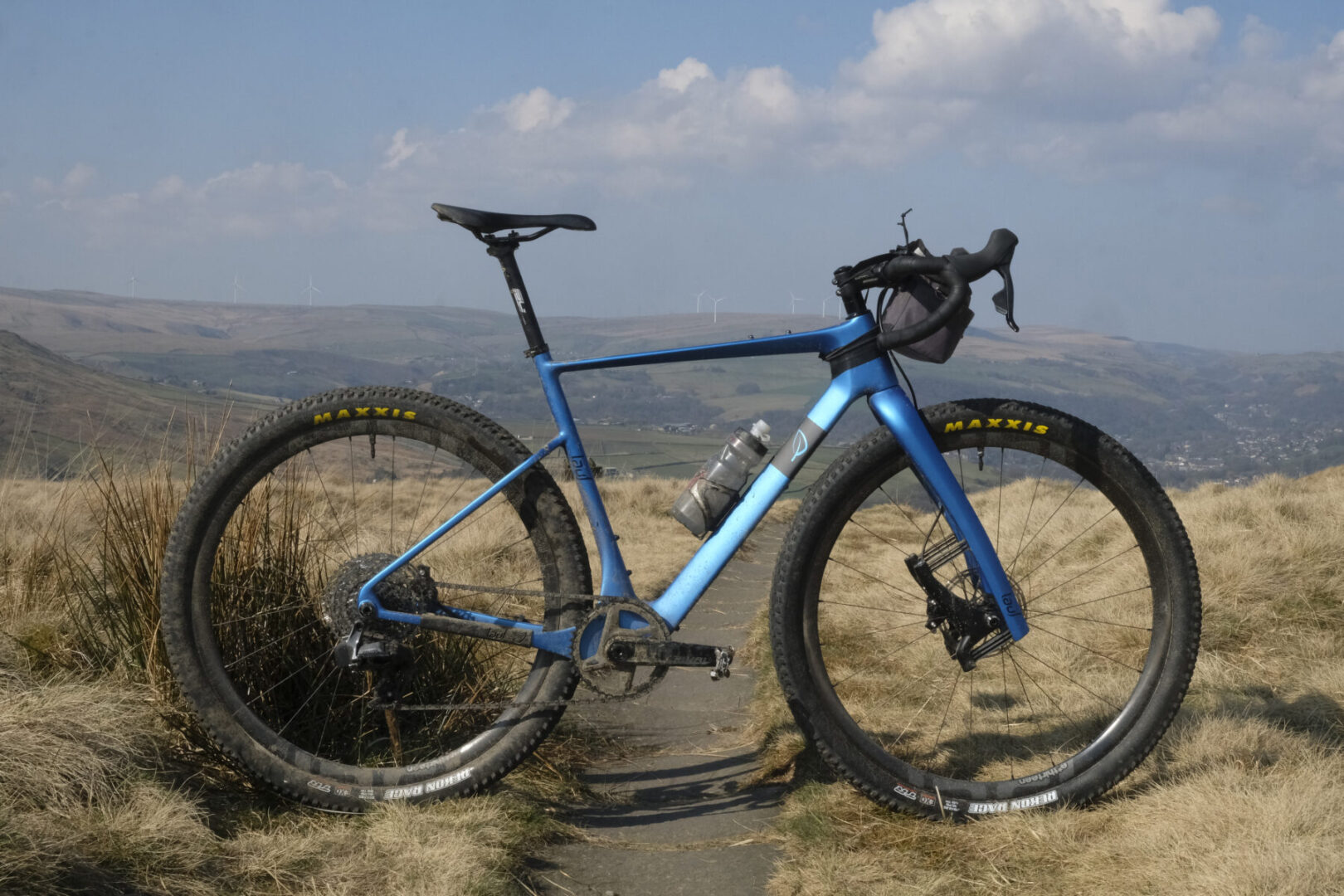

While the True Grit launched with a 45mm tyre capacity that was big for the time, the market has moved on and even larger volume tyres are becoming more commonplace. However, Lauf wanted to retain the race bike feel of the True Grit, rather than developing a whole other style of bike. The challenge then was to retain the geometry and weight of the True Grit while increasing tyre clearance. Luckily, a few technological developments offered the answer.

The first change was in shifting the bottom bracket to a BSA 73mm instead of a 68mm. By encouraging SRAM to produce Red and Force cranks in 73mm fitting, Lauf was able to increase the the BB without increasing the Q factor. That gained a few millimetres, and then a flat carbon plate was moulded in place on the drive side to give further clearance. This was made possible in part due to the advent of wireless shifting: normally you’d be looking at cable routing running inside the chainstay, which is not possible with this solid carbon plate design. If you do want to run manual shifting, then there is a cable port that exits just under the bottom bracket, and the chainstay protector doubles as a cable guide and mount, with attachment points built in.

Another change in the bottom bracket area is that the BB threads are cured into the frame, so there’s no sleeve bonded in. Between all these changes, Lauf says the overall frame weight remains close to the True Grit, adding only 25g, while also adding some stiffness in the bottom bracket area. Plus, there’s now tyre clearance for up to a 29×2.25in tyre.

As well as enabling the fitting of larger volume tyres, Lauf wanted the Seigla to be more comfortable than the True Grit. The fork gives riders plenty of comfort up front, which then gives the rear a harsher feel by contrast. While Lauf has lodged patents for rear suspension, the Seigla uses the natural flex of carbon frame construction without the need for any specific suspension components like leaf springs or pivots. The dropped seat stay may look very similar to the Cannondale Topstone, but there are no elastomers or pivots in here. Instead, the top tube is tapered, thinning as it meets the seat tube, and the seat tube retains a basic seat clamp rather than the integrated ones we’ve increasingly seen on modern bikes. The simple seat clamp allows the junction of the seat stays, seat tube and top tube to stay flexible, since there is no built up material in there to accommodate an integrated clamp.

All of this adds up to a flexible arrangement that offers approximately 4mm of flex when sitting on the bike, which increases up to about 12mm if you hit something like a pothole. Lauf has calculated that the movement is equivalent to that found on a Trek Isospeed – but without any serviceable parts or pivots.
Lauf explains it as follows:
1. The slim rear-portion of the top tube transforms the top tube / seat tube junction to a virtual pivot. For maximum effect, the use of a standard seat-clamp means that the virtual pivot is as close to the optimal (rearmost) location as possible.
2. The vertically slim seatstays allow twist up/down while the generous lateral dimensions resist lateral flex.
3. The dropped seatstays channel the ground force so that it bends the seat tube (since 1. and 2. above permit), resulting in a back/down movement of the saddle and a little dose of rear axle travel to go with it.
4. The offset and tilted seat tube doesn’t just provide tire clearance, it translates into a (more desirable) more downwardly suspension path for the saddle. Note that the rearwards portion of seatpost flex doesn’t add comfort, it is only the downwards component that counts.
5. More exposed seatpost than on the True Grit and Anywhere (+14-20mm, depending on frame size).
It’s worth noting that you get a suspension or compliance effect when seated, but not standing – like a URT suspension system.
Other updates for the Seigla include a slightly longer fork – just 8mm or so – to accommodate the larger tyre volume. The extra weight from the material needed to extend the fork uppers has been offset by changes to the internal structure of the lowers, which are now slightly lighter. The rear axle has changed as the Seigla uses the SRAM UDH, and the fork axle is now 12x100mm instead of the previous 15x100mm.
Lauf Seigla Geometry and Sizing
Since a key aim with the redesign was to retain the True Grit geometry, there aren’t many surprises here. The chain stays remain at an agility inducing 425mm, while the forks stays at 70.5 degrees. The seat post angle does look kind of weird, as it’s been offset to give the right angle to give the frame flex required. On the medium, it’s 69.9 degrees rather than 72.5 as on the True Grit, but the offset takes it back to an effective angle of about 72.5 if you have the saddle at about the height I would have it. It’s not quite so simple as that though – as well as changing with saddle height, this effective angle changes a little across the sizes, so it is 0.2 deg steeper on a small, and 0.2 deg slacker as you go up through the sizes from the medium.
| XS | S | M | L | XL | |
| Stem | 60, 7° | 70, 7° | 80, 7° | 90, 7° | 100, 7° |
| A Reach to handlebar | 421 | 435 | 456 | 477 | 498 |
| B Stack to handlebar | 562-604 | 579-623 | 608-654 | 639-688 | 671-722 |
| C BB to saddle top | 541-679 | 580-758 | 608-806 | 628-846 | 655-873 |
| D Frame reach | 378 | 383 | 394 | 405 | 416 |
| E Frame stack | 523 | 537 | 564 | 593 | 623 |
| F Head angle | 70.5° | 70.5° | 70.5° | 70.5° | 70.5° |
| G Seattube angle* | 72.9° | 72.7° | 72.5° | 72.4° | 72.3° |
| H Seattube lenght | 461 | 500 | 528 | 548 | 575 |
| I Chainstay length | 425 | 425 | 425 | 425 | 425 |
| J BB drop | 65 | 65 | 65 | 65 | 65 |
| K Headtube lenght | 84 | 99 | 129 | 159 | 191 |
| L Toptube length | 532 | 544 | 563 | 584 | 607 |
| M Wheelbase | 1009 | 1020 | 1040 | 1061 | 1084 |
| N Front-Center | 589 | 600 | 620 | 641 | 664 |
| O Axle to crown | 419 | 419 | 419 | 419 | 419 |
| P Fork rake | 47 | 47 | 47 | 47 | 47 |
| Q Standover height (on 45mm tires) | 731 | 763 | 789 | 811 | 840 |
| * +/- 0.1° depending on saddle height, slacker when higher, steeper when lower. |
It’s worth noting that the forks are tuned to the size of the bike – so fork on a small bike won’t take quite as much effort to compress as a fork on a large bike. It’s something you might want to bear in mind if you’re at either extreme of height for a particular bike, but also especially heavy or light. Another slight curiosity is that Lauf says the fork behaves differently at speed, due to the natural rebound speed of the leaf spring system, and a lighter rider will need to go a little faster to feel this difference in the fork’s behaviour.
Lauf Seigla Build Specs
There are three suspension build options, plus three rigid forked options. I was riding the base suspension model ‘Weekend Warrior Wireless’, with SRAM Rival AXS groupset. The Race Wireless build comes with SRAM ForceAXS, while the Ultimate comes with SRAM Red AXS. My WWW also comes with a single sided power meter and alloy wheels, where the other builds get dual sided meters and carbon wheels – although my WWW bike had been given a carbon wheel upgrade for the launch.
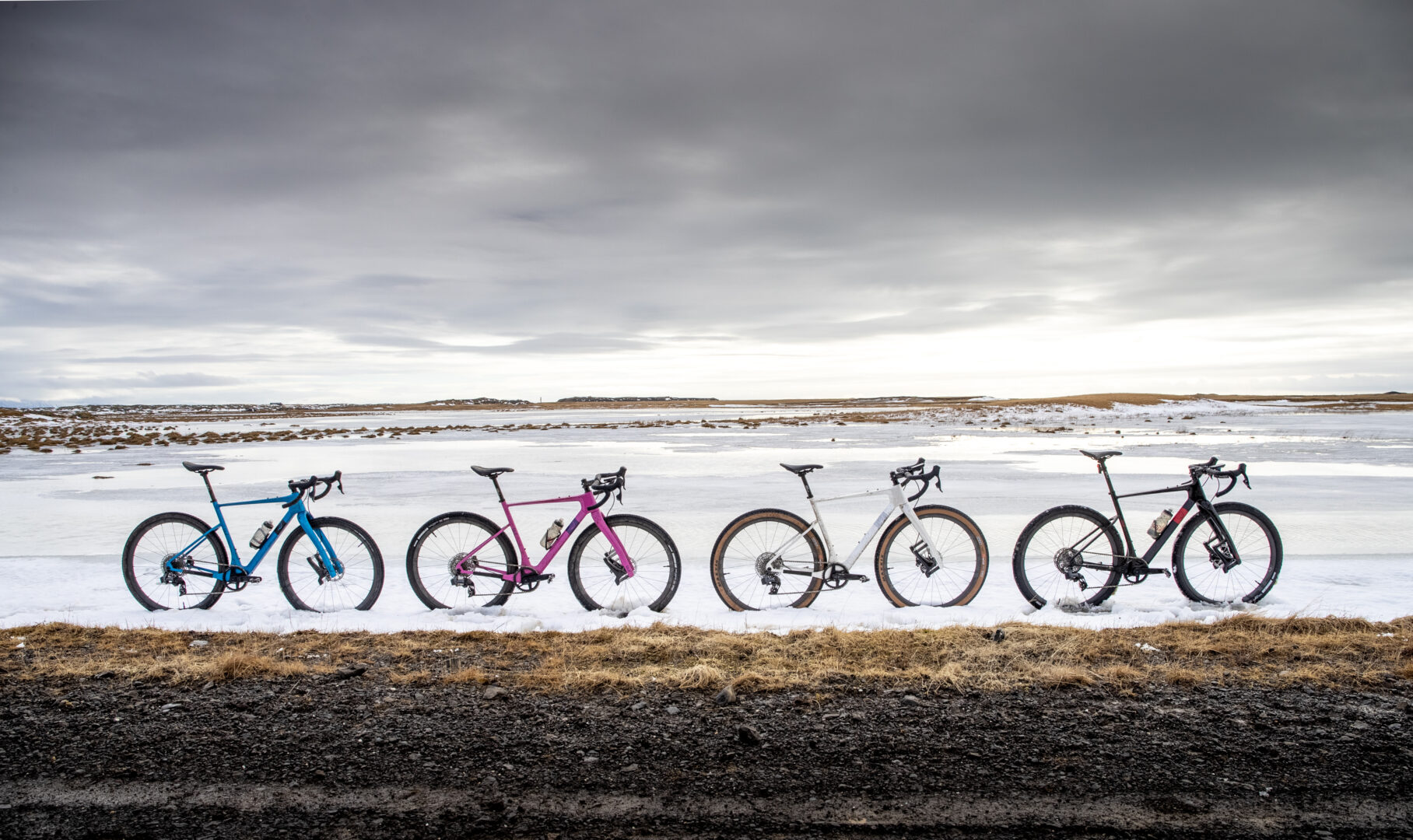
| Seigla Rigid – Weekend Warrior Wireless | Seigla – Weekend Warrior Wireless | Seigla Rigid – Race Wireless | Seigla – Race Wireless | Seigla Rigid – Ultimate | Seigla – Ultimate | |
| Frame | Lauf IRM* Seigla carbon frame, 12x142mm thru-axle | Lauf IRM* Seigla carbon frame, 12x142mm thru-axle | Lauf IRM* Seigla carbon frame, 12x142mm thru-axle | Lauf IRM* Seigla carbon frame, 12x142mm thru-axle | Lauf IRM* Seigla carbon frame, 12x142mm thru-axle | Lauf IRM* Seigla carbon frame, 12x142mm thru-axle |
| Fork | Lauf JAF 2nd gen IRM* Carbon, 12x100mm thru-axle | Lauf Grit 3rd gen IRM* Carbon, 12x100mm thru-axle, size tuned stiffness | Lauf JAF 2nd gen IRM* Carbon, 12x100mm thru-axle | Lauf Grit 3rd gen IRM* Carbon, 12x100mm thru-axle, size tuned stiffness | Lauf JAF 2nd gen IRM* Carbon, 12x100mm thru-axle | Lauf Grit 3rd gen IRM* Carbon, 12x100mm thru-axle, size tuned stiffness |
| Handlebar | Lauf Smoothie (XS/S: 40 M: 42 L/XL: 44) | Lauf Smoothie (XS/S: 40 M: 42 L/XL: 44) | Lauf Smoothie (XS/S: 40 M: 42 L/XL: 44) | Lauf Smoothie (XS/S: 40 M: 42 L/XL: 44) | Lauf Smoothie (XS/S: 40 M: 42 L/XL: 44) | Lauf Smoothie (XS/S: 40 M: 42 L/XL: 44) |
| Rear Derailleur | SRAM Rival AXS XPLR, wireless shifting | SRAM Rival AXS XPLR, wireless shifting | SRAM Force AXS XPLR, wireless shifting | SRAM Force AXS XPLR, wireless shifting | SRAM Red AXS XPLR, wireless shifting | SRAM Red AXS XPLR, wireless shifting |
| Shifters | SRAM Rival AXS, wireless shifting | SRAM Rival AXS, wireless shifting | SRAM Force AXS, wireless shifting | SRAM Force AXS, wireless shifting | SRAM Red AXS, wireless shifting | SRAM Red AXS, wireless shifting |
| Brakes | SRAM Rival Flat mount Hydraulic (160mm rotor front/left and rear/right) | SRAM Rival Flat mount Hydraulic (160mm rotor front/left and rear/right) | SRAM Force Flat mount Hydraulic (160mm rotor front/left and rear/right) | SRAM Force Flat mount Hydraulic (160mm rotor front/left and rear/right) | SRAM Red Flat mount Hydraulic (160mm rotor front/left and rear/right) | SRAM Red Flat mount Hydraulic (160mm rotor front/left and rear/right) |
| Crank | SRAM Rival 1 Wide DUB 42t | SRAM Rival 1 Wide DUB 42t | SRAM Force 1 DUB 40t | SRAM Force 1 DUB 40t | SRAM Red 1 DUB 40t | SRAM Red 1 DUB 40t |
| Power meter | Single-side, SRAM Rival AXS power meter spindle | Single-side, SRAM Rival AXS power meter spindle | Dual-side SRAM AXS power meter spider | Dual-side SRAM AXS power meter spider | Dual-side SRAM AXS power meter spider | Dual-side SRAM AXS power meter spider |
| Saddle | Fizik Aliante R5 | Fizik Aliante R5 | Fizik Aliante R5 | Fizik Aliante R5 | Fizik Aliante R5 | Fizik Aliante R5 |
| Seatpost | FSA V-Drive 27.2mm | FSA V-Drive 27.2mm | FSA SL-K 27.2mm, Carbon | FSA SL-K 27.2mm, Carbon | FSA SL-K 27.2mm, Carbon | FSA SL-K 27.2mm, Carbon |
| Wheels | e*thirteen XCX Aluminum (6-bolt, xDR freehub, tubeless ready) | e*thirteen XCX Aluminum (6-bolt, xDR freehub, tubeless ready) | e*thirteen XCX Race Carbon (6-bolt, xDR freehub, tubeless ready) | e*thirteen XCX Race Carbon (6-bolt, xDR freehub, tubeless ready) | e*thirteen XCX Race Carbon (6-bolt, xDR freehub, tubeless ready) | e*thirteen XCX Race Carbon (6-bolt, xDR freehub, tubeless ready) |
| Tires | Maxxis Rambler 40c (120tpi) | Maxxis Rambler 40c (120tpi) | Maxxis Rambler 40c (120tpi) | Maxxis Rambler 40c (120tpi) | Maxxis Rambler 40c (120tpi) | Maxxis Rambler 40c (120tpi) |
| Stem | FSA V-Drive, 6° | FSA V-Drive, 6° | FSA V-Drive, 6° | FSA V-Drive, 6° | FSA V-Drive, 6° | FSA V-Drive, 6° |
| Headset | FSA Orbit, IS 42/52 (45°lower) | FSA Orbit, IS 42/52 (45°lower) | FSA Orbit, IS 42/52 (45°lower) | FSA Orbit, IS 42/52 (45°lower) | FSA Orbit, IS 42/52 (45°lower) | FSA Orbit, IS 42/52 (45°lower) |
| Bartape | Lauf Lush | Lauf Lush | Lauf Lush | Lauf Lush | Lauf Lush | Lauf Lush |
| Cassette | SRAM 1251, 12 speed, 10-44t | SRAM 1251, 12 speed, 10-44t | SRAM 1271, 12 speed, 10-44t | SRAM 1271, 12 speed, 10-44t | SRAM 1271, 12 speed, 10-44t | SRAM 1271, 12 speed, 10-44t |
| Chain | SRAM Rival flat-top | SRAM Rival flat-top | SRAM Force flat-top | SRAM Force flat-top | SRAM Red flat-top | SRAM Red flat-top |
| Bottom Bracket | SRAM DUB BSA73 | SRAM DUB BSA73 | SRAM DUB BSA73 | SRAM DUB BSA73 | SRAM DUB BSA73 | SRAM DUB BSA73 |
| Price | £2,890 | £3,150 | £3,890 | £4,150 | £5,090 | £5,350 |
Despite the big volume tyre capacity, Lauf will only be offering the bikes with a 45mm tyre, as holding stock of all the options is not possible for them. You’ll have to order anything bigger yourself. And despite that large tyre volume, the bike remains a race bike – it’s not kitted out for bike packing adventures nor wild trail silliness. There are bottle mounts and a top tube mount, but no mudguard, rack or Anything cage mounts on either the rear of the frame or the fork. You also don’t really get dropper post compatibility: if you did add one it would really need to be wireless, but in any event the material of the dropper post lower would likely affect the natural flex in the frame, losing you some comfort and compliance.
All the build options offered by Lauf will be wireless – if you want cables, you’ll either need to build it yourself using the cable guide on the chainstay protector, or you’ll have to opt for the True Grit. For the time being at least, the True Grit will effectively be the budget offering in the Lauf range, with the Seigla being the higher end option.

If you don’t want the Lauf suspension fork, you can get a rigid fork option in all the Seigla build levels, and if you only want the new larger volume compatible suspension fork, you’ll be able to buy it as an aftermarket option. The rigid fork build will only be available in the black and red colour scheme, but suspension builds will be available in addition metallic blue, metallic/pearlescent white, and a dark raspberry pink.

Because of the 73mm bottom bracket – and wireless shifting – you also don’t get a Shimano option. Some other brands do make road BSA 73mm cranks, but as yet, not Shimano. Finally, if you loved the Lauf bottle opener that featured on the True Grit – or front mechs, as this attachment point gave compatibly for – then you’re out of luck. Creating space for the larger tyres meant getting rid of the carbon material necessary in this area to support that.

Three things I loved
- It is genuinely comfortable to pedal. Your bag of bones will feel significantly less shaken than on many other bikes, even if you pump the tyres up firm or go for a narrower width.
- The no-service fork. Just ride it and keep riding it. Maybe ride it some more.
- It’s light without feeling fragile.
Three things I’d change
- It’s missing the things it needs to be more than a race bike. Dynamo routing would be useful on a long distance race bike too, and perhaps the absence of any luggage/mudguard bosses on the fork or back of the frame seems like weight saving taken too far.
- I’d offer a wider or more flared bar to go with wider tyres.
- Personally I think the colour options are a bit meh. The white is too impractical, the black/red is too boring, and the pink is too marmite. Plus, the blue and pink both cost a fair whack extra.
The Ride – On The Seigla’s Home Turf
- Tested: Lauf Seigla Weekend Warrior Wireless, with carbon wheel upgrade: £2,890 + wheels
For the launch, only size medium bikes were available. I’m 175cm tall, which has put me onto small size gravel bikes on a number of occasions, but just squeaks me into being recommended for a medium Lauf. I was a little worried I was going to find the medium too large, however, having set it up and climbed on, I found it fairly compact and I think a small would have felt too cramped, especially with the large volume tyres coming fairly close to my toes (but not touching) on the medium. Since the forks are tuned to the size of the bike, I might have got a little more squish out of a size small fork, but as it would turn out, I was quite comfortable. I was also interested to see how the seat tube angle would feel, as on mountain bikes with slacker seat tubes I’ve found my knees complain on long inclines.
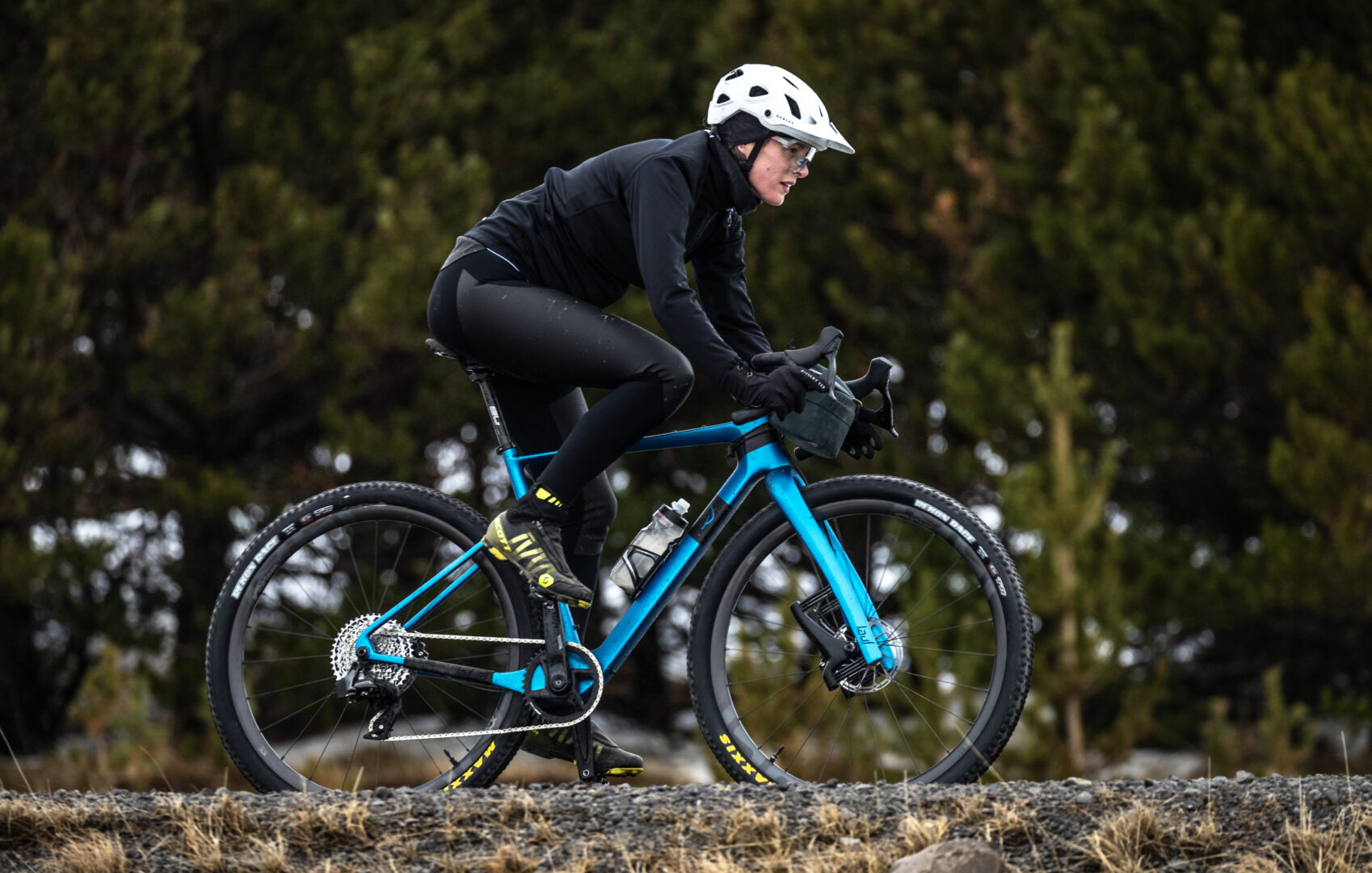
This race inclined set up is not my usual gravel bike proclivity, but with my saddle forward on the rails and a spacer swapped to raise the bar up a little, I found myself feeling quite comfortable. Which was just as well as we proceeded to tackle two days of very pedally riding which are also not my usual proclivity.

The launch was held in Iceland in March, after a particularly long and snowy winter. With the island’s interior – the mountains and valleys seen in all the tourist brochures – still under feet or inches of snow, we had to stick to the fringes of the island, in the flat lands close to the sea. A mix of paved and gravel roads awaited us, with barely any elevation to speak of. However, the ground was in the process of thawing, turning many sections of gravel into sponge-like softness. Here, there was no firm line through – like a beach ride, you just had to keep spinning, wrestle the bars, and hope to maintain forward motion until the ground ceased sucking you in and released you to pedal onwards. At one point, we stood to the side of the track to let a milk tanker pass us. The ground wobbled, as if we were standing on a trampoline. A strange sensation indeed, and one that went some way to illustrate just how much momentum these soft sections were sucking from us.
I chose to try out the bike with the 29×2.25in Maxxis Rekon Race tyres. Initially I rode with them at around 20psi, which was very comfortable, but in the soft ground felt like riding with a flat tyre. Pumping the tyres up to 40psi, the ground still sucked at me in the soft sections, but there was a greater contrast and immediate significant picking up of the pace as soon as I hit firmer ground. There were no stiff climbs at all on the route we did, but on road sections and firm ground the Seigla seemed plenty stiff and responsive. Whatever you put into the pedals transfers into power through the bike, but doesn’t come back to visit you through bone shaking or bum bruising through the frame.
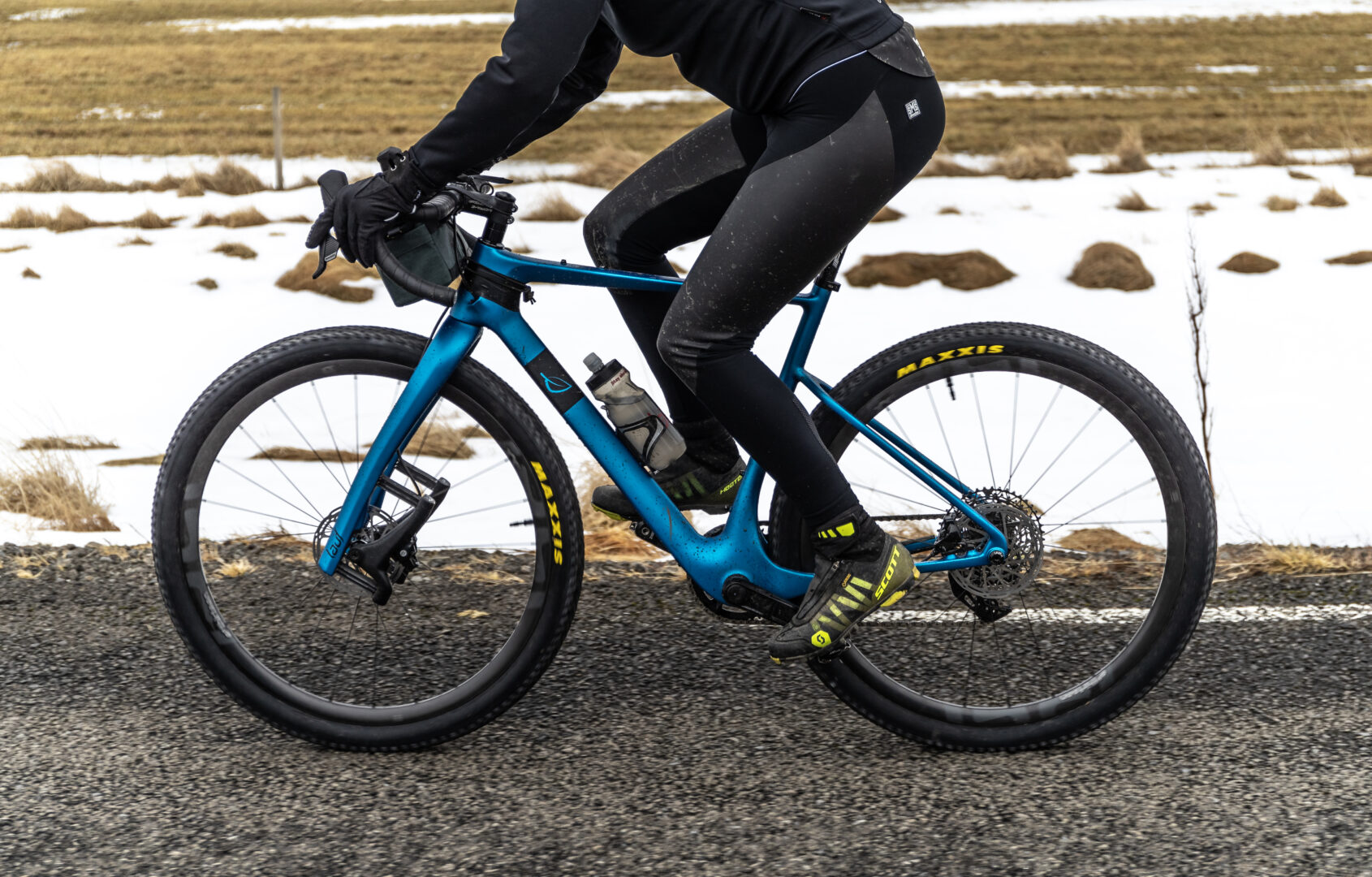
For me, the wider tyre needs a wider – or at least more flared – bar. While the fork and slightly flexible bar certainly gave me a comfortable ride in terms of sharp judders or shaking, I found that the constant micro corrections of steering gave me tired arms. Riding in the drops on the slight flare gave me a little better control, but then put more weight forward onto my arms, fatiguing them in a different way. If you’re planning on fitting a larger tyre, I’d also recommend adding a wider or more flared bar to your shopping cart too. This isn’t unique to the Seigla – I’ve thought this with other drop bar/wide tyre combos, but with the suspension fork taking the other arm fatigue element of bone shaking out of the equation, it seems a shame not to go all in on the comfort front.

And it is comfortable. I would not normally choose to ride a gravel bike with such a racy position, and I would not choose to stay seated for nearly 78km of of constant pedalling. To be honest, I would be unlikely to choose 78km of shuttle runs either. The Icelandic test rides I experienced were pushing me way out of my normal realm of bicycle activities. Standing up just wasn’t helpful – the hills didn’t need it, and the wind would generally just see you as a larger sail and make pedalling all the harder. It was very much a hunker down, keep pedalling, and hide behind the protection of a larger and stronger rider if at all possible. Echelons! Drafting! It was a veritable exercise in road race tactics. On gravel. Soft, speed sucking sponge gravel, hard frost proof coarse tarmac, and hard packed puddle strewn gravel. Sat down. All. The. Time. And yet, my poor unaccustomed undercarriage suffered very little. I rode, I slept, I got up and rode again, and yet still I was in less pain than I’ve experienced after far shorter mountain bike rides. The anticipated sensation of celibacy seeming like a sensible and attractive prospect was not forthcoming. I can only conclude that all the effort that went into making the bike’s rear end more compliant has worked, and has worked very well.

The Ride – On My Home Turf
Having stopped riding gravel bikes in the past due to experiencing nerve pain in my arm, I was really keen to do further riding of the Seigla on the kind of terrain I’m more accustomed to taking a gravel bike on – namely singletrack trails where I’d like to add a bit of extra spice. Would it open up the drop bar world on my doorstep again? I also wanted to see how that seat tube angle would work out on my steep local climbs, to see how the fork would perform against the repeated hits of a packhorse trail descent, and to find out whether the frame would put up with the occasional flying baby head rock on my local bridleway descents.



The 42T chainring and 10-44T cassette proved somewhat challenging on my home hills. Certainly for climbing off road in poor weather I’d be looking for easier gears – and in due course the WWW builds will swap from a 42T to a 40T, like the other builds. The electronic shifting is easy to use and encourages you to keep a steady cadence through regular shifting. Maybe the Force and Red options are lighter and crisper, but I’ve never used them and the Rival seemed absolutely fine to me. Contrary to my fears, I had no issues with the geometry of the bike, and my knees seem perfectly happy with the position of my feet in relation to my hips.
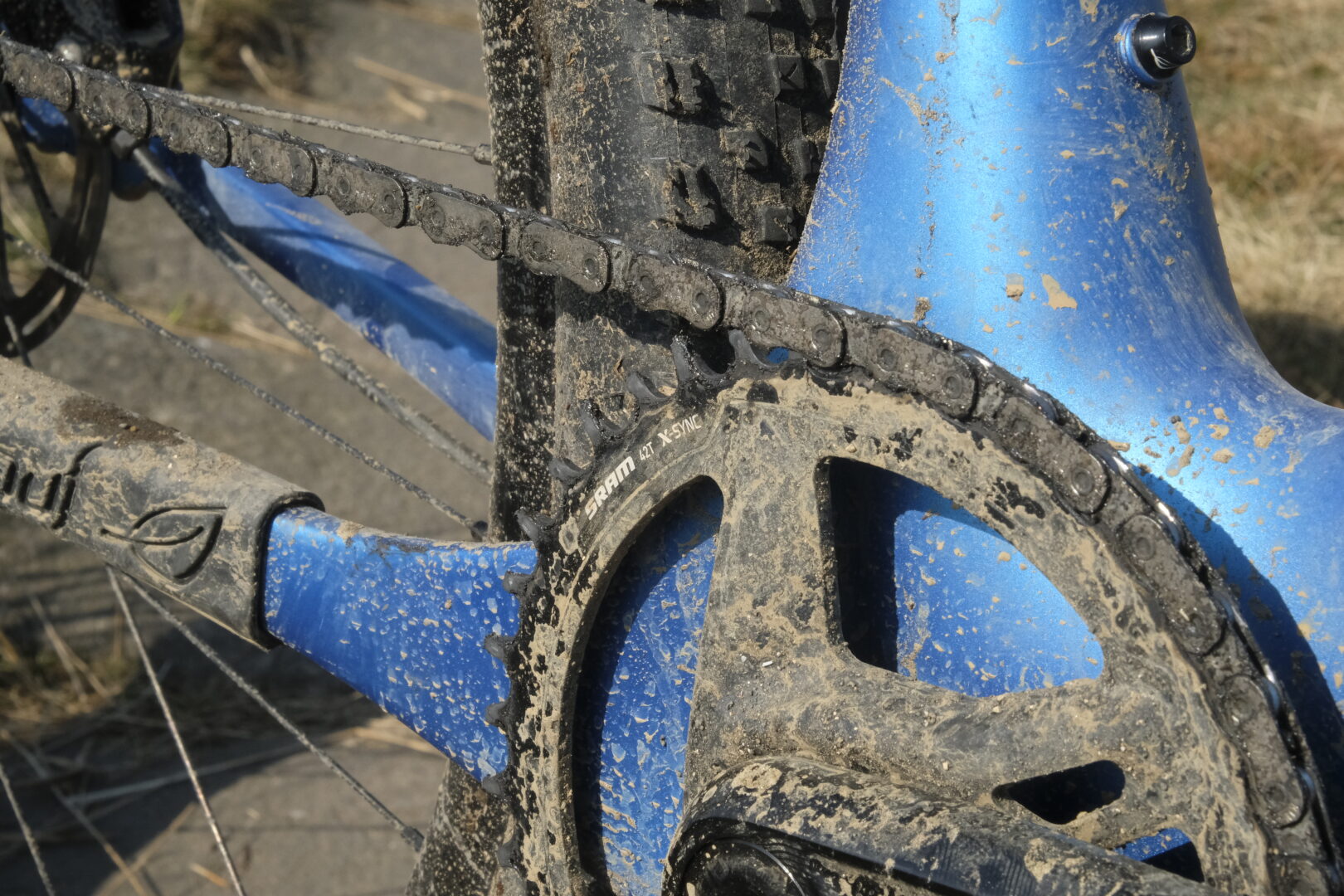






In the interests of experimentation, I swapped out the tyres for some 700x45C Hutchinson Tundras. This addressed the desire to have wider bars for proportional control over the tyre, and made it yet more fleet of foot on less bumpy terrain. However, the mostly unflared drops, despite their flexion for comfort, make for tough braking on steep descents. Adding weight – those Lauf bars are floaty light – I’ve added some Sonder Bomber bars. These are very flared, and I know from experience how much more comfortable they make braking on steep off road terrain with drop bars – your hands, wrists and arms just align better. With the wider tyres for extra comfort and traction, all the bike needs now to be more Calderdale friendly is a smaller chainring. I guess until I get my hands on one of them, I’m just working on my muscle mass.
The rougher terrain around me did give me chance to make some observations that I missed on the gravel of Iceland. Firstly, under compression I experienced the occasional buzz of the large volume tyre against the front brake hose. A closer look at the cable mounts suggests that there might be room to shift the mount up a little more, making sure that the hose is completely clear of the tyre before wiggling its way to the handlebars. It’s a minor point, and can be solved by some careful cable tying and tucking, but especially if you are going to add a bar bag you should take extra care with the routing here.

While the fork does take the buzz and judder out of the ride, the compliance in the frame is in the upper part – so that the chatter doesn’t transfer through your saddle. Which, of course, you only get the benefit of if you’re actually sitting on. On my local terrain, where I often stand to climb (especially with a 42T chainring) and stand to descend, the full benefit of the comfort this bike offers on pedally gravel is lost. In addition, on the steepest of rocky descents – where I’m probably pushing the boundaries of intended use for a gravel bike – I felt that the fork could on occasion feel like it was pitching me forward as it moved through the first part of its travel. This is not a mountain bike fork designed for big hits, it’s a gravel fork for smoothing out the chatter, especially at speed. As such, if your gravel riding consists, like mine does, of making tamer local mountain bike trails more interesting, probably in a slow speed tech kind of way, then this is not really the bike for you.

These limitations mean I think that the relative lack of dropper post compatibility is not an issue – if you need a dropper post, you’re probably going to be having other sorts of trouble that mean you should have chosen a different bike. I’m not sure I agree with the lack of mounts though – yes, there are some super fast and light long distance racers who will get on very well indeed with the Seigla, but I think a few more features – especially dynamo routing – would broaden the appeal just a little more.
However, if your gravel riding consists of going fast over actual gravel, or fireroads, then the Seigla does that very well indeed. In fact, the faster you go, the more comfortable it is – the sensation is kind of like the difference between taking a pump track slowly, and getting it perfectly timed, or of finding the sweet spot to make a wine glass sing as you run a finger around it. There’s a sort of flow to it at a certain speed on the right terrain. If you want to whizz round events like the Dirty Reiver, or tackle the South Downs in a day, then you should definitely give the Seigla some thought. For this sort of riding, the larger volume tyres are probably rarely necessary, though for some surfaces I think they’ll give you the confidence you want to be able to hit that speed at which the fork starts to sing.
I can imagine the long distance countryside commuter getting on with this, even with the lack of mudguard options – you could whizz your way to work then have all kinds of mixed surface fun on your way home on long summer days, then stick on bigger tyres for extra grip on grim winter commutes. It is a bike for riding at pace, whatever your motives. If you’re sitting and pedalling, this will keep you comfortable, fore and aft. With electronic shifting keeping pedalling smooth and the built in power meter to help you tick off the effort as you put in the miles, plus comfort under bum and hands, there’s everything you need to ride a very long way indeed.
Overall
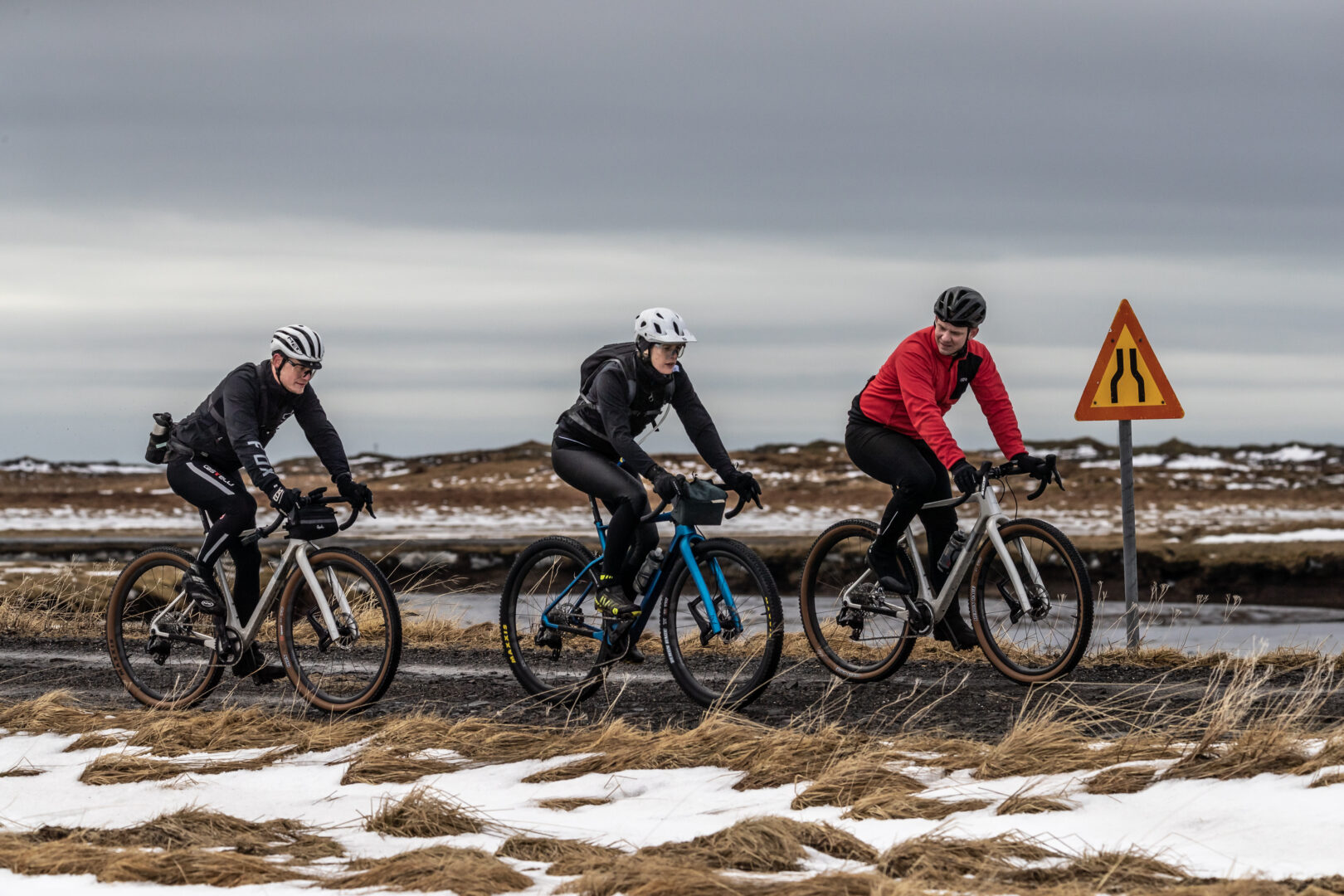
On balance, I think the big selling point here is not the tyre clearance but the frame compliance. If you want big tyres all the time there are likely other bikes that will suit your riding better. But it’s nice to know you have the option if you want it occasionally. If you ride the kind of gravel rides that mix up road and gravel surfaces and you’re likely to be sitting down and pedalling for hours at a time, then the Seigla will let you do so in surprising comfort. I can see that for places like Iceland and the USA, where public dirt roads are common, the Seigla makes an awful lot of sense. If your gravel gets chunkier, there’s tyre clearance for big enough tyres to keep things feeling rollable, though it feels like it’s a bike that wants to go fast, so too much chunk is not really what it’s about. It’s only when you start pointing down things that are steep and rough enough to justify a mountain bike that you’ll really find its limits. But that’s not what it’s been designed for, and if that’s what you want to do it’s not for you. That said, you might just find that riding a Seigla makes you recalibrate your gravel-ometer, and sees you adding some of the finer faster stuff in to the mix.
Comments (3)
Leave Reply
Post Comment
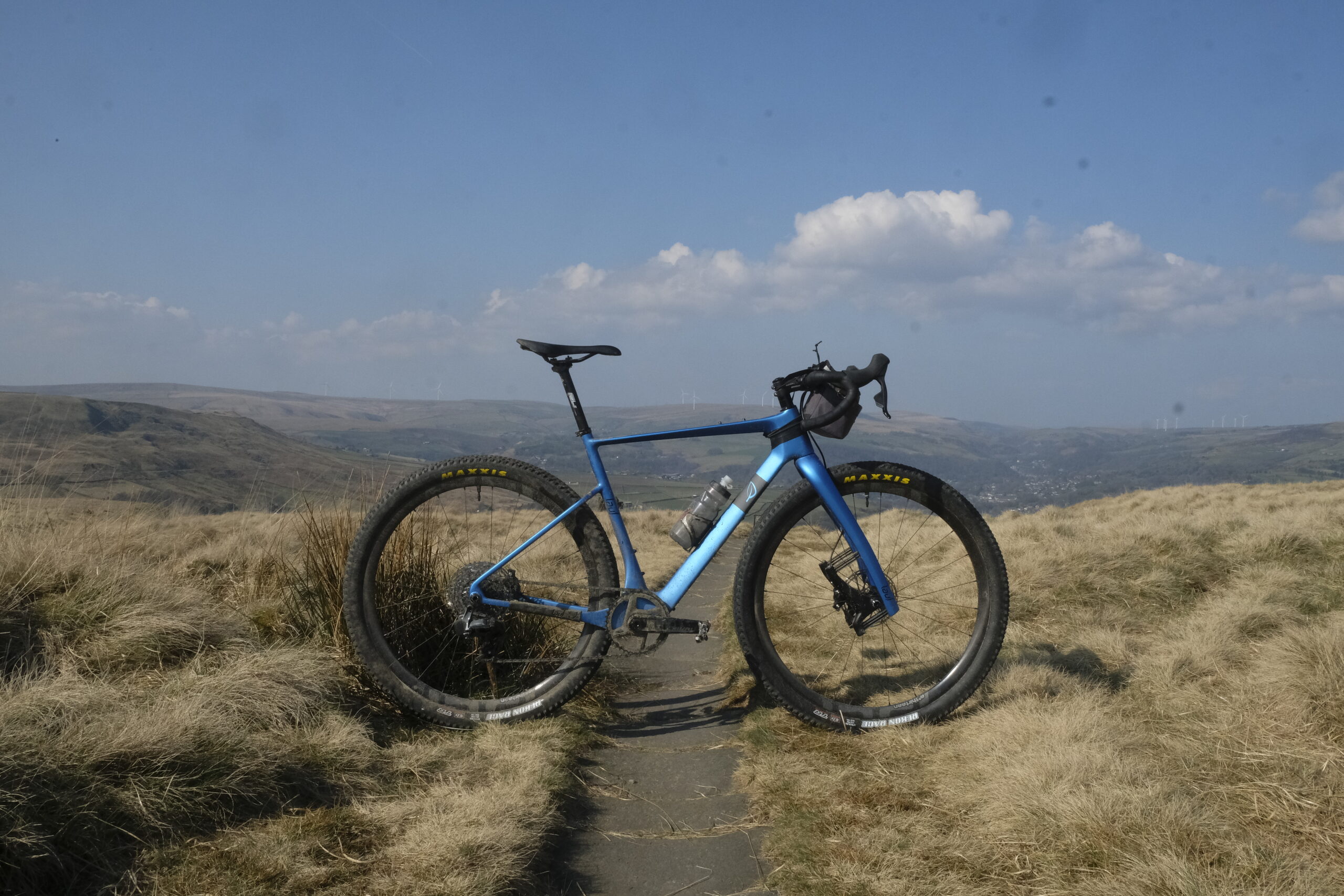

Has anyone got one?
Yep, have one. Used for a year. I think the review is fair. 40t or 38t front chainring is required for off-road climbs if you are mortal. It definitely makes faster rough sections of tracks more comfortable, but is not a substitute for an XC mountain bike.
Thanks @pooniepoonie, it would be replacing my cx bike.
I’m a little concerned with buying something costing thousands of pounds from a company based in the US, especially paying in Dollars.
How was the buying process?
Was the tax easy to sort?
Was the delivery ok?